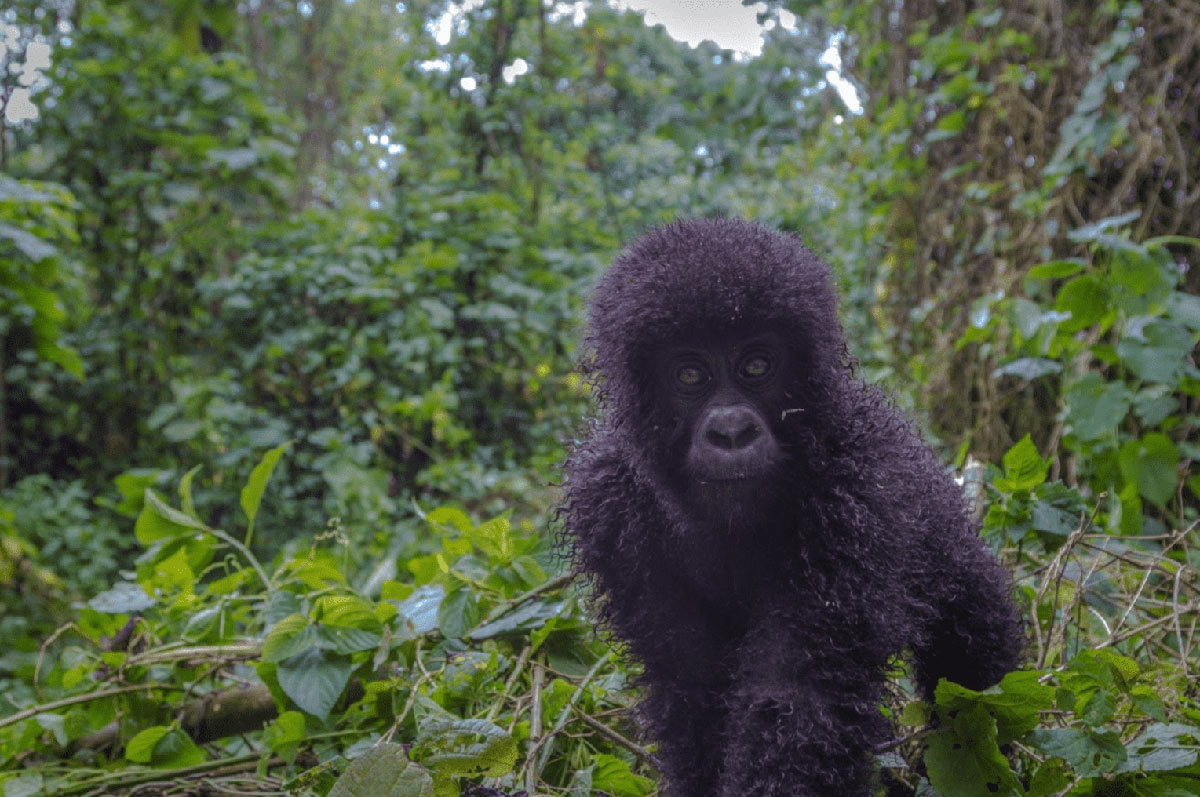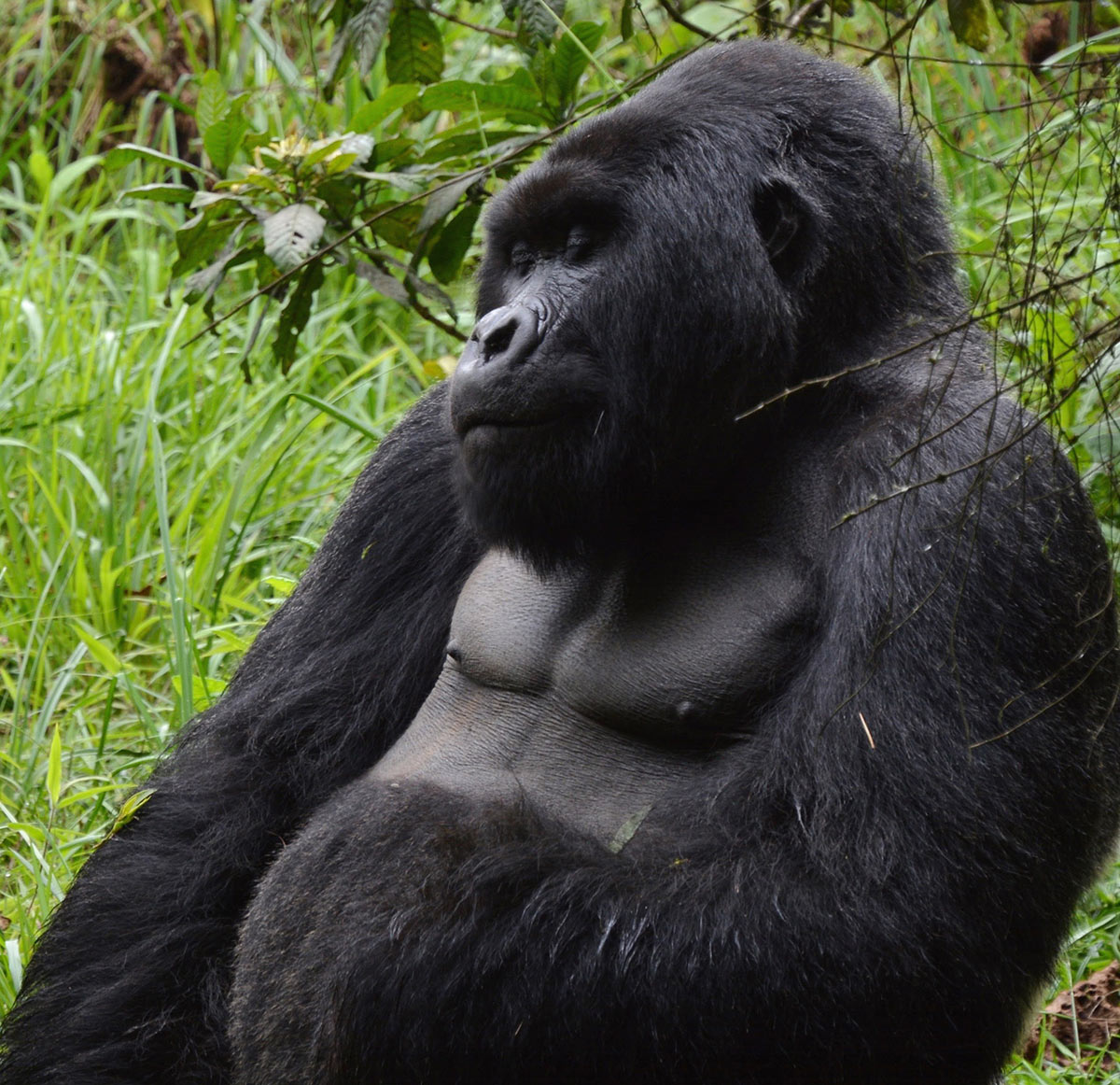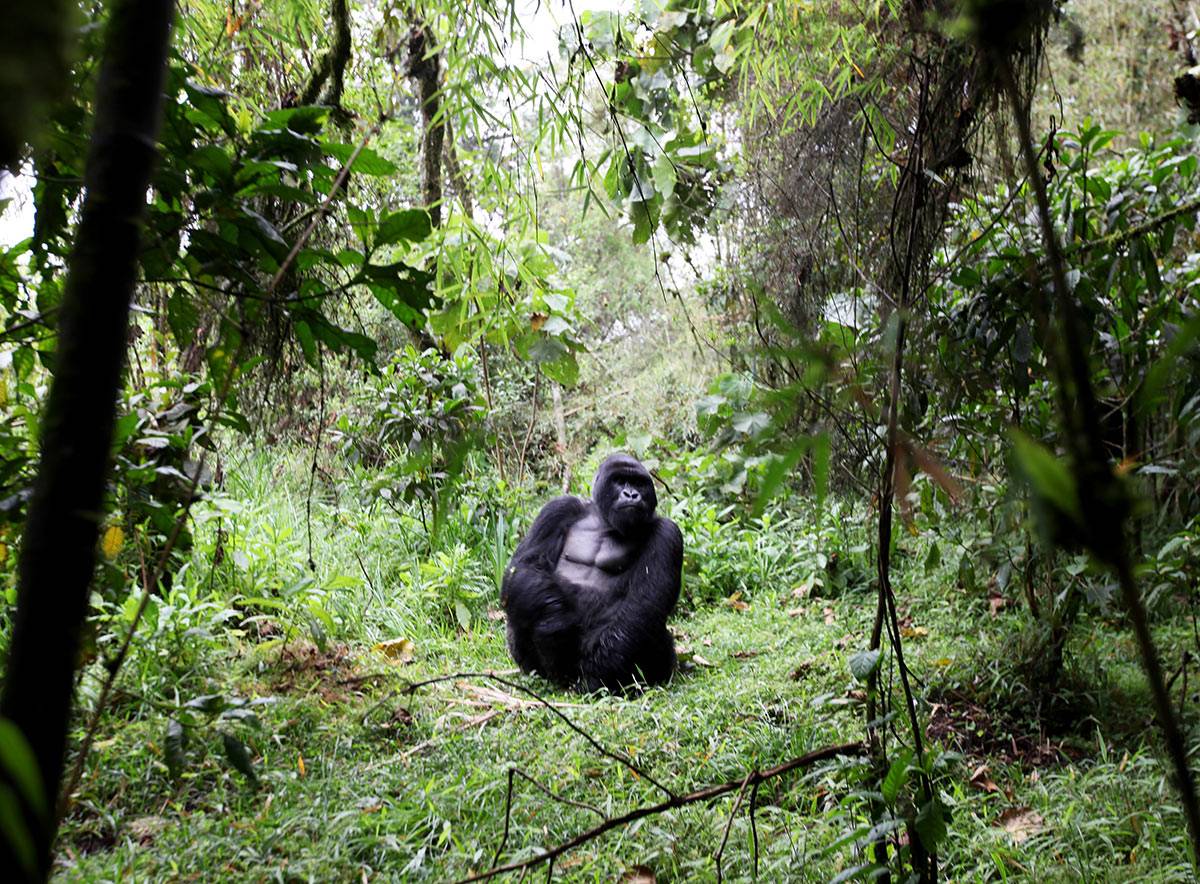Gorilla trekking is one of the most exhilarating experiences in the world. Sitting meters away from silverbacks and their family is incredible – this article has everything you need to know if you are thinking about experiencing it for yourself
Where can I see mountain gorillas in Africa?
Gorillas live in equatorial Africa. They can be seen in Rwanda, Uganda, and the Democratic Republic of Congo (DRC).
Mountain gorillas, a subspecies of gorilla, live in the eastern part of central Africa in two groups – one in the Virunga Volcanoes across Uganda, Rwanda and Democratic Republic of Congo, and one in Bwindi Impenetrable National Park, Uganda, which connects to Sarambwe Nature Reserve, DRC.
What kind of gorillas are there?
There are two species of gorilla, both live in equatorial Africa, but are separated by about 560 miles of Congo Basin forest. They are split into the eastern gorilla and the western gorilla. Each of the two species of Gorilla has two subspecies, one which lives in the lowlands and one which lives in the highlands.
The Western Lowland Gorilla (Gorilla gorilla gorilla) and the Cross River Gorilla (Gorilla gorilla diehli) live in the west of the region, whereas the Mountain Gorilla (Gorilla beringei beringei) and the Eastern Lowland Gorilla or Grauer’s gorilla (Gorilla beringei graueri) live in the east.
How many mountain gorillas are left in the wild?
There are just over 1,000 mountain gorillas in the wild according to the latest census. The exact populations of the different species of gorilla are hard to know because they inhabit some of the most dense and remote rainforests in Africa. All species of Gorilla are endangered or critically endangered.
While the population of mountain gorillas has shown a slight increase in recent years, they still face numerous threats to their survival. Habitat loss, poaching, and human-wildlife conflict continue to pose significant challenges to their conservation. Efforts by conservation organizations, local communities, and governments have played a crucial role in protecting these majestic creatures, but more work is needed to ensure their long-term survival. Increasing ecotourism, implementing strict anti-poaching measures, and engaging with local communities are essential steps in safeguarding the future of mountain gorillas and their fragile ecosystems. By raising awareness and taking action to address these threats, we can help secure a brighter future for these incredible animals.
Is it safe to see gorillas?
Gorilla trekking is safe for both humans and gorillas, as long as safety precautions and visitation rules are followed.
The gorilla troops that are visited on a trek are habituated. This means they’ve passed through a long process of slowly becoming accustomed to the presence of humans. This makes them less likely to become alarmed and agitated by our presence.
A limited number of permits to visit gorillas are issued per day, to avoid causing too much disruption to the animals. It is a legal requirement to have an expert guide with you to visit gorillas. The guide ensures that visitors and gorillas remain safe during an encounter. Additionally, visitors embarking on a gorilla trek are advised to maintain a safe distance from the primates at all times to minimize any potential stress or disturbances to the animals. It’s crucial to follow the rules and guidelines set by the park authorities to protect both the endangered gorilla species and humans. As long as these precautions are diligently observed, gorilla trekking can be a truly remarkable and safe wildlife experience, allowing for a unique opportunity to observe these majestic creatures in their natural habitat.
How dangerous are gorillas to humans?
It’s valid to feel vulnerable when seeing large and powerful gorillas in the wild, but gorillas are not interested in hurting humans. Gorillas will defend themselves if attacked or threatened, but they’re not naturally aggressive creatures. They are gentle giants (and vegetarian), but it’s still important to remember that they are wild animals and must be respected.
Gorillas, despite their immense strength and size, exhibit remarkable restraint and are known to display behaviors that are more curious than threatening towards humans. Being primarily herbivores, their nature is peaceful and non-confrontational. Nevertheless, interactions with wild animals always carry an element of unpredictability, and it is crucial for humans to maintain a respectful distance and refrain from provoking these magnificent creatures in their natural habitats. By understanding and respecting the boundaries of wildlife, we can coexist harmoniously with these gentle giants and foster a sense of mutual respect and admiration.
Why are gorillas endangered?

The commercial trade in bushmeat throughout west and central Africa is the biggest threat to gorillas today. They also suffer from habitat loss due to deforestation. This contributes to their struggle with the bushmeat trade because logging routes create paths for hunters to be able to access previously inaccessible areas of the forest. The Ebola virus, which is deadly to both gorillas and humans, is also having an effect. Efforts to protect gorillas are often hampered by weak law enforcement, and civil unrest in many places where gorillas live.
Gorillas reproduce slowly, giving birth to only one baby at a time and then raising their infant for several years before giving birth again. This slow reproduction rate makes gorillas vulnerable to population declines because it takes many generations for numbers to recover.
Why are gorillas poached?
Gorillas are poached for their meat. The demand for ape meat is due to the attitude that it is a delicacy among the wealthy elite. Gorilla’s size makes them easy targets for hunters and in some areas gorillas are favored by hunters because of the weight of meat they can sell.
In addition to being poached for their meat, gorillas are also targeted for their body parts, as they are believed to have medicinal or magical powers in traditional medicine practices. The illegal trade of gorilla body parts fuels further poaching, posing a significant threat to the already vulnerable gorilla populations. Furthermore, habitat destruction driven by human activities such as logging and agriculture forces gorillas into smaller, fragmented areas where they are more susceptible to poaching. Conservation efforts and stricter enforcement of anti-poaching laws are crucial in safeguarding these magnificent creatures from further exploitation.
How much does it cost to go gorilla trekking?
In order to go gorilla trekking, you must obtain a gorilla permit. A gorilla permit includes interacting with the gorillas, park entrance fees and ranger fees. The cost of a gorilla permit varies depending on which country you are in, ranging from $700 USD per person per day in Uganda, to $1,500 per person per day in Rwanda.
Is gorilla trekking worth the money?
Gorilla trekking is one of the most thrilling wildlife activities in Africa and indeed the world. Once you sit a few meters from a four-hundred-pound silverback and his family, you gain a unique new perspective on the natural world. The awe-inspiring experience of gorilla trekking goes beyond just observing these majestic creatures in their natural habitat. It offers a profound opportunity to witness their social dynamics, behaviors, and interactions up close, fostering a deeper appreciation for the intricacies of the animal kingdom. The sheer thrill of being in such close proximity to these powerful yet gentle giants leaves a lasting impression on all who embark on this adventure. Additionally, the conservation efforts supported by gorilla trekking tourism play a vital role in protecting these endangered species and their fragile ecosystems. The memories and insights gained from a gorilla trekking expedition are truly priceless, making it a worthwhile investment for those seeking a truly unforgettable wildlife encounter.
Why are gorilla trekking permits so expensive in Rwanda and Uganda?
Gorilla trekking permits are expensive because a large proportion of the costs go directly into gorilla conservation and protection. Gorilla conservation involves significant investments into scientific research and employing rangers and scientists to carry out the work. Approximately 75% of gorilla permit fees go into conservation initiatives to protect endangered mountain gorillas in the wild. Roughly 15% of the money collected from gorilla permits goes to the government and the remaining 10% goes to the local communities. The permit fees cover the cost of running the treks at a high standard of safety for both humans and gorillas, so as to not affect the well-being of the gorilla troops. Rather than increase the number of people who visit the gorillas each day, conservationists have raised the price per permit, helping to mitigate any negative impacts of ecotourism.
How much is a gorilla trekking permit in Rwanda?
A gorilla trekking permit in Rwanda costs $1,500 USD per person per day. The high cost of the gorilla trekking permit in Rwanda reflects the country’s commitment to conservation efforts and sustainable tourism practices. By imposing such a fee, the Rwandan government aims to limit the number of visitors, reducing the environmental impact on the gorillas’ natural habitat and ensuring a more exclusive and less disruptive experience for those fortunate enough to embark on this adventure. This strategy also helps generate revenue that can be reinvested into local communities and wildlife protection initiatives, ultimately contributing to the long-term survival of the critically endangered mountain gorillas.
How much is a gorillas trekking permit in Uganda?
A gorilla trekking permit in Uganda costs $700 USD per person per day. The gorilla trekking permit is a crucial aspect of the whole experience, as it allows visitors to track and observe these magnificent creatures in their natural habitat. The cost of the permit goes towards conservation efforts, protecting the gorillas and their habitat from threats such as poaching and habitat destruction. By paying for a permit, visitors are not only gaining a memorable and unique experience but also contributing to the preservation of these endangered species for future generations to enjoy.
Is it better to see gorillas in Uganda, Rwanda, or Congo?
The three countries where gorillas live and can be visited are Uganda, Rwanda, and Congo.
Gorilla trekking in Uganda has a higher fitness requirement. The roads and hiking are more strenuous and the slopes are steep. Uganda’s national parks are a very safe place to visit gorillas. The cost of a gorilla viewing permit in Uganda is less than Rwanda.
In Rwanda, visiting the gorillas is still challenging, but the hiking is less strenuous and the roads are slightly less demanding than in Uganda. Rwanda is one of the safest countries in Africa to visit. The cost of a gorilla viewing permit is higher in Rwanda than in Uganda.
The Congo is currently a less safe place to visit gorillas, and this is part of the reason Gondwana Ecotours does not visit there.
What is a silverback gorilla?
The term “Silverback” refers to adult male Mountain Gorillas (Gorilla beringei beringei), who develop a silver-gray patch on hair on their back as they mature. These majestic primates are known for their impressive strength and leadership within their social groups. Silverback gorillas play a crucial role in maintaining order within their family units, making important decisions, and protecting their troop from potential threats. Their large size and distinctive silver saddle make them easily recognizable in the dense forests of Central Africa. Despite their intimidating appearance, silverbacks are generally gentle and prefer to avoid conflict, using displays of power and vocalizations to assert dominance when necessary. The presence of a silverback is essential for the well-being and survival of the entire gorilla group.
What is the difference between a silverback and a gorilla?
Only male gorillas become silverbacks, females do not develop the gray patch of fur on that part of their bodies. In addition to the distinct physical characteristic of the silverback patch, male gorillas earn the title of silverback due to their age, experience, and leadership within the gorilla group.
Do all male gorillas become silverback gorillas?
All male gorillas become silverbacks as they age, but not all become dominant.
Gorillas are classed as infants until they reach three years old and become adults from 8 years old. Males that are aged between 8-12 years old are referred to as ‘blackbacks’. From around 12 years old, males begin to develop a silver section of hair on their back, these males are referred to as ‘silverback’. While all male gorillas do eventually become silverbacks as they age, not every silverback assumes a dominant role within the group. Dominance among gorillas is typically established through physical strength, social skills, and the ability to lead and protect the group. Some silverbacks may choose to live a more solitary life or may not be successful in securing a dominant position within a group due to competition from other males. This dynamic of hierarchy and dominance plays a crucial role in the social structure and stability of gorilla groups in the wild.
How are gorillas related to humans?
We share 98.3% of our DNA with gorillas, making them our closest relatives after chimpanzees and bonobos.
This can mean that human illnesses, even a common cold, can have detrimental impacts on gorillas. In fact, due to the high genetic similarity between gorillas and humans, diseases can easily jump between the two species. This poses a significant threat to the well-being of gorilla populations, especially those living in close proximity to human settlements or tourist areas. To mitigate this risk, conservationists and researchers often implement strict health protocols when studying or monitoring gorillas in the wild to prevent the transmission of diseases. Additionally, efforts are being made to raise awareness about the importance of conservation and the potential consequences of human-gorilla disease transmission to ensure the long-term survival of these incredible creatures.
How strong are gorillas?
A gorilla’s strength is estimated to be about 10 times their body weight. Fully grown silverbacks are approximately as strong as 20 adult humans combined. Gorillas are not only strong but also incredibly agile and dexterous. Their muscular build allows them to effortlessly climb trees and swing from branches with remarkable ease. In addition to their physical prowess, gorillas exhibit complex social behaviors within their groups, showing both nurturing and protective instincts towards their young ones. It is truly fascinating to witness the blend of power and gentleness that these magnificent creatures possess.
How old do gorillas get?
The average lifespan of a gorilla in the wild is 35 years, but some live to much older, even sometimes reaching 50 years old. In captivity, gorillas have been known to live even longer due to receiving specialized care and attention from their keepers. With proper nutrition, medical care, and a safe environment, some gorillas have been able to surpass their wild counterparts in terms of longevity. There have been recorded cases of gorillas living well into their 50s and even 60s in captivity, showcasing the positive impact that human intervention can have on the well-being and lifespan of these incredible creatures.
What do gorillas eat?
Gorillas are mainly vegetarian and spend almost half of their day feeding on shoots, stems, and a variety of fruits. They supplement this with tree bark, insects, snails, roots, and rotting wood, which is a good source of sodium.
Gorillas play an important role in maintaining forest biodiversity by spreading the seeds of trees and by opening up gaps in vegetation as they move through the forest. This lets in light and allows a diverse set of plants to grow. Their foraging habits not only contribute to the ecosystem’s balance but also aid in sustaining the lush vegetation of the forests where they reside.
How much does a gorilla eat per day?
An adult male gorilla can eat up to 40 pounds (18 kilograms) of food each day, mainly in the form of vegetation. Due to their large size and energy requirements, gorillas spend a significant portion of their day foraging for food. Due to their large size and energy requirements, gorillas spend a significant portion of their day foraging for food. They have a herbivorous diet, primarily consisting of leaves, stems, fruits, and occasionally insects. The vegetation provides them with essential nutrients and sustains their bulky physique. Gorillas have a remarkable digestive system that allows them to efficiently process the high-fiber plant material, ensuring they meet their nutritional needs despite the vast quantities they consume. In their natural habitat, gorillas have a crucial role in shaping the ecosystem through their feeding habits, influencing plant distribution and diversity.
How do gorillas communicate?
Gorillas communicate through sounds and movement. They have been known to make at least 22 distinct sounds to communicate different feelings, such as chuckling when they feel playful and screaming when they feel scared. They also communicate through facial expressions, postures and gestures. In addition to vocalizations and body language, gorillas also use olfactory communication to interact with one another. They rely on scent marking to establish territories and convey information about their identity, reproductive status, and emotional state. By leaving urine and feces in specific locations, gorillas can communicate important messages to others in their group or neighboring troops. This olfactory communication plays a crucial role in maintaining social bonds and resolving conflicts within gorilla communities.
How do gorillas play?
The main way that gorillas play with each other is through wrestling. They hug, bite, throw, hit, and hold on to each other. Young gorillas play more frequently than adults, but adults sometimes join in. Playing is very important for young gorillas, it helps them to get familiar with other members of the group and find their pace in the family. They practice communication and learn patterns of behavior through the act of play.
Additionally, apart from wrestling, gorillas also engage in various playful behaviors such as chasing each other, climbing trees, and swinging from branches. These playful activities not only serve as a form of physical exercise but also play a crucial role in strengthening social bonds within the gorilla group. Through play, gorillas learn important life skills such as problem-solving, cooperation, and conflict resolution while having fun and building relationships with their fellow group members. It is fascinating to observe how these intelligent creatures use play as a tool for both learning and socializing in their natural habitat.
How do you safely talk to or interact with a gorilla?
Your expert guide will always be on hand to offer guidance when you are visiting gorillas, but there are a few key points that are good to remember.
When you come across a gorilla troop, it’s important to keep quiet and move slowly, always following your guide’s instructions so as not to startle the gorillas. For the same reason, never use flash photography with the gorillas. Don’t wear bright colored clothing or strong-smelling body sprays.
Try not to make eye contact with the gorillas, but if you do, immediately look down to show them you are not a threat. Don’t make sudden movements or loud noises as this could alarm the gorillas.
Maintain a safe distance from the gorillas, according to your trek guide’s instructions. This is for your own safety as well as that of the gorillas, as the distance helps to prevent the spread of human diseases to the gorillas.
If a gorilla moves closer to you, stay still, and let them pass by. If the gorilla approaches you and sits down, slowly move away to resume a safe distance. Don’t worry if you aren’t sure about what to do, your expert guides will be watching closely and are there to instruct you as to the best way to move. Find more safe African safaris.

Resources:
https://www.worldwildlife.org/species/gorilla
https://www.nationalgeographic.com/animals/mammals/facts/mountain-gorilla
https://www.wwf.org.uk/learn/fascinating-facts/gorillas
https://www.nationalgeographic.com/animals/article/animals-aging-gorillas-elephants-primates



